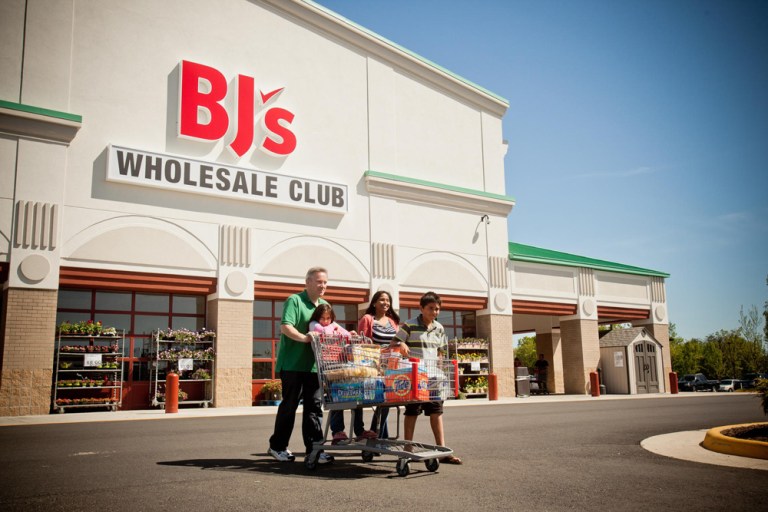
Big —but not massive — is a tough spot to be in, as the team and BJ’s Wholesale Club can readily attest. BJ’s is the third largest brick-and-mortar wholesale retailer in the United States and is by no means a small operation. The chain currently operates 211 club locations and 126 gas stations across 15 states and employs over 25,000 people.
However, in the wholesale retail Olympics, the difference between gold-medal holder Costco and silver medalist Sam’s Club is rather narrow. Costco is the second largest retailer in the U.S., whereas Sam’s is the wholesale offshoot of the United States’ largest retailer, Walmart.
The gulf between the two top spots and bronze metal holder BJ’s is much more pronounced.
Costco more than doubles BJ’s warehouse store count with 447, operates in almost three times as many states (43) and has seven times the number of employees (174,000). Sam’s Club, despite its lower revenue and sales than Costco, is larger still with 653 stores in 47 states.
BJ’s smaller and mostly East Coast centric offering in 2015 — Ohio is as far west as the chain goes, operating nearly entirely in the North and Southeastern U.S. — largely comes as an offshoot of a bit of historical bad luck.
BJ’s today is approximately the same size Costco was in 1994 when it merged with Price Club. BJ’s was smaller, but not at quite such a massive size disadvantage then. However, at that point, when Costco was thriving, BJ’s hit a disastrously bad string of earning quarters spurred on by supply chain problems and poorly managed attempts at scaling up the business 20 years ago. To essentially staunch the bleeding, then-CEO Herb Zarkin slowed down the firm’s pace of expansion. Meanwhile, Costco continued to grow and picked up massive market share during the Great Recession, when their bulk discounting was particularly attractive to consumers.
“BJ’s spent years fixing itself and didn’t have time for growth. Costco was never broken and it never stopped growing,” noted Howard Davidowitz, chairman of Davidowitz & Associates Inc.
However, by 2011 the turnaround project at BJ’s finished up, and the store was reporting significant gains in revenue and same-store sales. And the firm made an interesting move: it went private and sold to two private equity firms (Leonard Green & Partners and CVC Capital Partners).
And that partnership is significant, as Leonard Green has something of a reputation in retail. Previous purchases have included J.Crew, Neiman Marcus, The Container Store and Petco — and their standard MO involves buying and using the power of their checkbook to help those brands build out.
“The warehouse business requires a lot of stores because you run on narrow margins and need to make it up in volume,” says George Whalin, of Retail Management Consultants. “I guess BJ’s is looking at Leonard Green to help them accomplish that.”
However, even with an expansion-friendly partner, expansion has been a slow if steady process, with BJ’s having added about 15 new stores in the last two years — and more planned for 2016.
A process, analysts note, that may soon get something of a shot of adrenaline with recent changes made at the top of BJ’s executive team.
Earlier this month, BJ’s Wholesale Club has appointed President/COO Christopher Baldwin to the position of president/CEO, effective Feb. 1, 2016. Baldwin succeeds Laura Sen, a 25-year veteran with the firm who took the company through the private equity purchase. Sen will remain on the board as non-executive chairman and continue to focus on the firm’s long-term goals.
“I believe BJ’s is operationally strong and well-positioned for continued success,” said Sen. “In a very short period, Chris has demonstrated the necessary vision and leadership to take BJ’s to the next level. Together, we have laid out a strategy for the company that will serve us for many years to come, and I believe now is the right time for Chris to assume his place as leader of BJ’s.”
Baldwin joined BJ’s in September. Before that, he was CEO of Hess Retail Corp.
“I am humbled and excited by this opportunity to lead BJ’s,” said Baldwin. “This is both a challenging time for retail and one full of opportunity. Our guide over the next several years will be a vision that is steadfastly focused on offering a distinctive shopping experience and deep value proposition to BJ’s millions of loyal members. With the support of BJ’s team members, I look forward to leading our company to even higher levels of achievement.”
BJ’s also managed to grab some rarely captured headlines as one of the big retail chains to be accepting Apple Pay — beating both Costco and Sam’s Club to the mobile payments punch (though, given Sam’s ownership by Walmart, it is likely that accepting Apple Pay is a priority that chain will be getting to precisely never). The chain expanded up on that news just in time for the holiday shopping season this year with the further announcement that BJ’s members can now officially start storing their store-issued credit card in their Apple Pay wallet.
Up until that point, Kohl’s had been the only retailer to add support for Apple Pay to its store cards. JC Penney is expected to launch support, but not before the spring of 2016
“As we’ve seen use expand since we started accepting Apple Pay, the natural next move was to expand so that our store cards would sync up with it easily,” a spokesman noted in a statement to PYMNTS.
Running third in a race with competitors well ahead of you is nothing if not a challenge — but it is a challenge that BJ’s thinks it is ready for. And perhaps, even has a small advantage in, as many physical retailers are now finding those big ’90s build outs are ill-suited to modern shopping preferences.
It might just be, by accident, BJ’s has a chance to build out its business so it is right-sized, instead of overly super-sized.